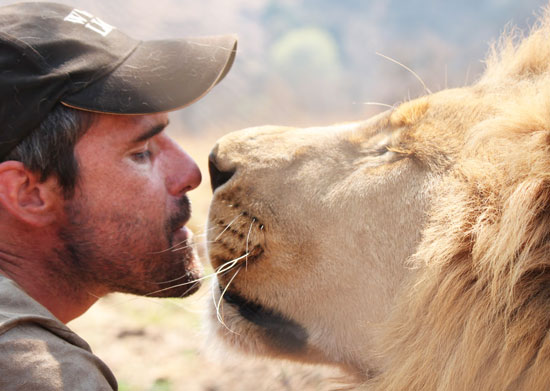Step by step guide to talking with animals

Each time you want to talk with an animal, always start by sending a feeling of total, unconditional love. The same love you feel for the person you love most in the world.
How to tell an animal something, so that they understand
1. Send a feeling of love to the animal, tell “I love you”.
2. Sometimes it helps to see a bridge of light connecting your heart to the animal’s heart. This is the bridge that your messages to each other travel along. This is the heart connection.
3. You might feel a strange feeling in your heart, like your heart is bursting with love. Sometimes it makes you want to laugh out loud, or sometimes it makes you feel like crying. Don’t worry about it, just feel it. This is you feeling the heart connection.
4. Hold a picture in your mind of what you want to tell the animal. For example, if you want your dog or cat to come towards you and sit next to you, stay very still and calm and see him doing just that in your mind.
5. “See” that image in a bubble floating from you towards the animal.
6. Trust that they have received the message.
7. When using words, focus on what you would like the animal to do, not on what you don’t want him to do. Take the words “no” and “don’t” out of your vocabulary.
You can speak out loud or quietly in your mind. Our words automatically tie in with the pictures in our head, that is why it is so important to think positively when sending your message.
People really think in pictures, not in words, and that is what the animals pick up when they are “reading our minds”. If someone says to you “Do not think of a pink elephant with wings!” what are you thinking of? We just can’t help it. So when you ask an animal not to do something, they get very confused because they see the picture of them doing what you don’t want them to do, and they want to do it.
They also pick up on our feelings, they know when we are happy, or sad, or cross. We never have to tell them that, and we can’t lie to an animal about how we are really feeling, because they know what is in our hearts. But sometimes we do need to tell them why we are upset or sad, so that they can understand better.
8. When you have finished it is important to say “thank you” to the animal/s for listening.
How to Listen to the Animals
The first basic rule in listening, besides loving and respecting the animals, is to trust yourself. Trust everything that comes to you.
1. Start by sending love.
2. Ask permission to communicate. Sometimes an animal is busy, and can’t “talk” right now. If they stay with you and seem happy to be there, carry on. If not wait until a later time.
3. Ask specific questions.
Asking the Questions
4. Ask the question and then let it go (don’t keep asking or thinking about it). “See” the question floating towards the animal/s and arriving there.
5. Ask one question at a time.
6. Trust that the animal has “heard” you.
7. Keep it simple: avoid complicated questions; focus on the reason and the feeling around the question.
8. Ask open, not closed questions. For example: “Are you happy?” is a closed question with only two possible answers, “yes” or “no”. “How are you feeling?” is an open question.
Avoid the use of “Why?” and rather use more open, gentle questions to ask about the reason the animal is doing something, like: “How do you feel when you are digging up the garden?” or “What makes you want to fight with the other cat?”
Getting the Answers

9. “See” the animal’s answer coming towards you in a bubble. As it arrives in your mind, this bubble pops and shows you the answer to your question.
10. Often the answer comes so quickly, even before you’ve finished asking the question.
11. Write down the very first thing that comes to you, even if it does not make any logical sense. This is where you start discovering how you receive messages from the animals. Take note: write down everything you experience, every thought, feeling, image or sensation that comes to you.
12. Stop thinking and just feel. You can think later. It is important to pretend that you don’t know anything about the animal, from reading books or what other people have told you. This is the time to work with your true inner knowledge and intuition, not with what you think you know.
13. End off with “Is there anything else you’d like to share?”
14. Once you have finished asking questions and have written down everything that you received, thank the animal/s for talking to you.
Sometimes you’ll get a feeling or a picture in your mind from an animal, even if you haven’t started asking any questions. This is when the animal wants to tell you something, and feels that you are open and ready to listen. It always helps to be very calm and still when you are with animals. When our minds are empty of silly things and our hearts are full of love and we are just enjoying the moment with the animals, that is the time when we are open and ready to listen to them.
yogaesoteric
November 4, 2017
